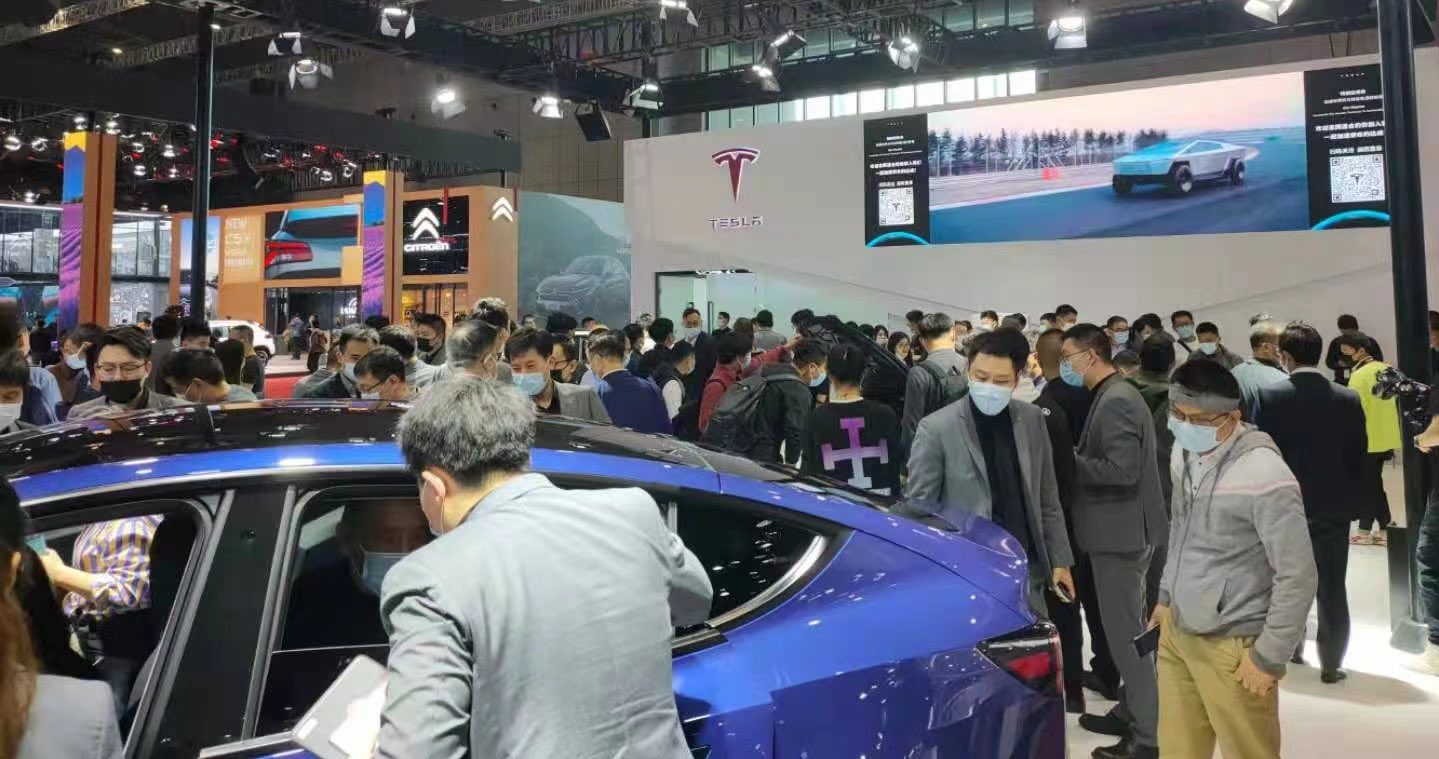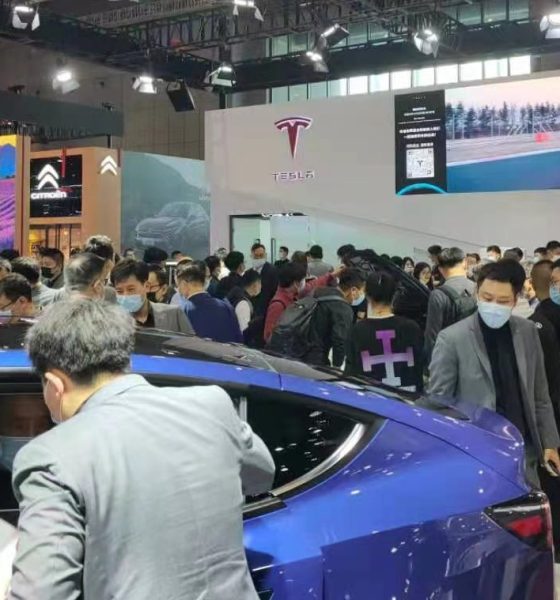

News
Tesla protest seemingly helps drive foot traffic to EV maker’s booth at Shanghai Auto Show
A day after a protest against Tesla in China that was covered by international media outlets, the EV maker’s booth at the Shanghai International Auto Show remained popular, with numerous visitors checking out the company’s all-electric vehicles. This could be seen in videos and images taken the day following the high-profile demonstration.
Based on pictures and clips of Tesla’s booth the day following the protest, the EV maker is still attracting large crowds of visitors. While a good part of this may very well be due to Tesla’s popularity in China and the Model 3’s rankings in the country’s EV sector, a part of the increased interest may have also been inspired by the news coverage that ensued following the protest.
Photo taken today at Shanghai Int’l Auto Show. Negative news brings visitors? https://t.co/GWH51xmx4Y pic.twitter.com/ydSztENnnU
— Ray (@ray4tesla) April 21, 2021
On Monday, Tesla’s booth at the Shanghai International Auto Show became the scene of some drama after a Model 3 owner climbed on top of one of the display vehicles and protested against the company, claiming that her vehicle’s brakes were faulty. The Model 3 owner was joined by another protester, who remained with the crowd. The two women wore shirts declaring Tesla’s alleged brake failures.
The woman on top of the Model 3 was promptly removed by guards at the event, though not before the protest attracted a notable degree of attention. Unfortunately for the protester, she was arrested by the Shanghai police for “disrupting public order.” The protester would also be in police custody for five days.
The saga of the Tesla protester started in February, when the woman’s Model 3 crashed into another vehicle at a speed the EV maker later determined was about 118 km/h (73 mph). The owner claimed that the crash was due to brake failure, though police have determined that the cause of the incident had been reckless driving since the Model 3 did not keep a safe distance from the cars in front.
The Tesla owner later took actions against her local Tesla service center, refusing repair and insisting on a full refund instead, plus compensation for lost wages. The owner also declined Tesla’s offer to have the vehicle taken to a third-party agency for an examination. Picket-line protests against the company were later organized, culminating in this Monday’s protest at the Shanghai International Auto Show.
Tesla, for its part, has responded to the incident, later apologizing to the Model 3 owner and establishing a dedicated “Special Handling Team” for customer concerns.
“We apologize for failing to solve the problem of the car owner in time… Tesla respects and firmly obeys the decisions of relevant government departments, respects consumers, abides by laws and regulations, and resolutely actively cooperates with all investigations of relevant government departments. To this end, we have set up a special handling team, dedicated to special handling, and strive to meet the demands of car owners and strive to satisfy car owners while complying with laws and regulations,” the company wrote.
Don’t hesitate to contact us for news tips. Just send a message to tips@teslarati.com to give us a heads up.

News
Tesla starts showing how FSD will change lives in Europe
Local officials tested the system on narrow country roads and were impressed by FSD’s smooth, human-like driving, with some calling the service a game-changer for everyday life in areas that are far from urban centers.

Tesla has launched Europe’s first public shuttle service using Full Self-Driving (Supervised) in the rural Eifelkreis Bitburg-Prüm region of Germany, demonstrating how the technology can restore independence and mobility for people who struggle with limited transport options.
Local officials tested the system on narrow country roads and were impressed by FSD’s smooth, human-like driving, with some calling the service a game-changer for everyday life in areas that are far from urban centers.
Officials see real impact on rural residents
Arzfeld Mayor Johannes Kuhl and District Administrator Andreas Kruppert personally tested the Tesla shuttle service. This allowed them to see just how well FSD navigated winding lanes and rural roads confidently. Kruppert said, “Autonomous driving sounds like science fiction to many, but we simply see here that it works totally well in rural regions too.” Kuhl, for his part, also noted that FSD “feels like a very experienced driver.”
The pilot complements the area’s “Citizen Bus” program, which provides on-demand rides for elderly residents who can no longer drive themselves. Tesla Europe shared a video of a demonstration of the service, highlighting how FSD gives people their freedom back, even in places where public transport is not as prevalent.
What the Ministry for Economic Affairs and Transport says
Rhineland-Palatinate’s Minister Daniela Schmitt supported the project, praising the collaboration that made this “first of its kind in Europe” possible. As per the ministry, the rural rollout for the service shows FSD’s potential beyond major cities, and it delivers tangible benefits like grocery runs, doctor visits, and social connections for isolated residents.
“Reliable and flexible mobility is especially vital in rural areas. With the launch of a shuttle service using self-driving vehicles (FSD supervised) by Tesla in the Eifelkreis Bitburg-Prüm, an innovative pilot project is now getting underway that complements local community bus services. It is the first project of its kind in Europe.
“The result is a real gain for rural mobility: greater accessibility, more flexibility and tangible benefits for everyday life. A strong signal for innovation, cooperation and future-oriented mobility beyond urban centers,” the ministry wrote in a LinkedIn post.
News
Tesla China quietly posts Robotaxi-related job listing
Tesla China is currently seeking a Low Voltage Electrical Engineer to work on circuit board design for the company’s autonomous vehicles.

Tesla has posted a new job listing in Shanghai explicitly tied to its Robotaxi program, fueling speculation that the company is preparing to launch its dedicated autonomous ride-hailing service in China.
As noted in the listing, Tesla China is currently seeking a Low Voltage Electrical Engineer to work on circuit board design for the company’s autonomous vehicles.
Robotaxi-specific role
The listing, which was shared on social media platform X by industry watcher @tslaming, suggested that Tesla China is looking to fill the role urgently. The job listing itself specifically mentions that the person hired for the role will be working on the Low Voltage Hardware team, which would design the circuit boards that would serve as the nervous system of the Robotaxi.
Key tasks for the role, as indicated in the job listing, include collaboration with PCB layout, firmware, mechanical, program management, and validation teams, among other responsibilities. The role is based in Shanghai.
China Robotaxi launch
China represents a massive potential market for robotaxis, with its dense urban centers and supportive policies in select cities. Tesla has limited permission to roll out FSD in the country, though despite this, its vehicles have been hailed as among the best in the market when it comes to autonomous features. So far, at least, it appears that China supports Tesla’s FSD and Robotaxi rollout.
This was hinted at in November, when Tesla brought the Cybercab to the 8th China International Import Expo (CIIE) in Shanghai, marking the first time that the autonomous two-seater was brought to the Asia-Pacific region. The vehicle, despite not having a release date in China, received a significant amount of interest among the event’s attendees.
Elon Musk
Elon Musk and Tesla AI Director share insights after empty driver seat Robotaxi rides
The executives’ unoccupied tests hint at the rapid progress of Tesla’s unsupervised Robotaxi efforts.

Tesla CEO Elon Musk and AI Director Ashok Elluswamy celebrated Christmas Eve by sharing personal experiences with Robotaxi vehicles that had no safety monitor or occupant in the driver’s seat. Musk described the system’s “perfect driving” around Austin, while Elluswamy posted video from the back seat, calling it “an amazing experience.”
The executives’ unoccupied tests hint at the rapid progress of Tesla’s unsupervised Robotaxi efforts.
Elon and Ashok’s firsthand Robotaxi insights
Prior to Musk and the Tesla AI Director’s posts, sightings of unmanned Teslas navigating public roads were widely shared on social media. One such vehicle was spotted in Austin, Texas, which Elon Musk acknowleged by stating that “Testing is underway with no occupants in the car.”
Based on his Christmas Eve post, Musk seemed to have tested an unmanned Tesla himself. “A Tesla with no safety monitor in the car and me sitting in the passenger seat took me all around Austin on Sunday with perfect driving,” Musk wrote in his post.
Elluswamy responded with a 2-minute video showing himself in the rear of an unmanned Tesla. The video featured the vehicle’s empty front seats, as well as its smooth handling through real-world traffic. He captioned his video with the words, “It’s an amazing experience!”
Towards Unsupervised operations
During an xAI Hackathon earlier this month, Elon Musk mentioned that Tesla owed be removing Safety Monitors from its Robotaxis in Austin in just three weeks. “Unsupervised is pretty much solved at this point. So there will be Tesla Robotaxis operating in Austin with no one in them. Not even anyone in the passenger seat in about three weeks,” he said. Musk echoed similar estimates at the 2025 Annual Shareholder Meeting and the Q3 2025 earnings call.
Considering the insights that were posted Musk and Elluswamy, it does appear that Tesla is working hard towards operating its Robotaxis with no safety monitors. This is quite impressive considering that the service was launched just earlier this year.








